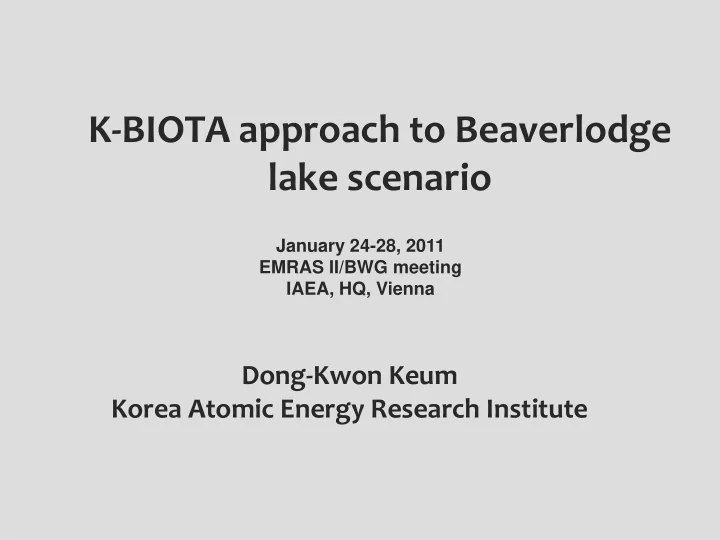

K ‐ BIOTA approach to Beaverlodge lake scenario January 24-28, 2011 EMRAS II/BWG meeting IAEA, HQ, Vienna Dong ‐ Kwon Keum Korea Atomic Energy Research Institute
Basic equation 1) The total whole body absorbed dose rate of radionuclide i for a specified organism in aquatic ecosystem w,i tot,i i int,i w ws d,i s d,i ext,i internal external 2) Input data ‐ C w : Water activity ‐ CR: Concentration ratio of organism to water ‐ γ : Occupancy factor ( w : water, ws : water ‐ sediment interface, s : sediment) ‐ K d : Equilibrium distribution coefficient of radionuclide i ‐ DCC: Dose conversion coefficients ( int : internal, ext : external)
� Input data ‐ Water activity � The water activity for a lake whose value was not provided was calculated by using the Kd value if the sediment activity (q w ) for the lake would be known w,i w,i d,i
� Input data ‐ Kd values � If the site specific Kd value for a lake was not available, the arithmetic mean of Kd values that had been provided for studied sites in this exercise was used. Arithmetic mean ERICA R/N The provided Kd for studied sites Kd (l/kg) tool Pb210 2.64E5, 1.1467E4, 3.13E5 1.02E5 1.0E5 Po210 3.94E5, 4.67E5, 2.1E4 2.94E5 2.0E7 Ra226 2.99E4, 2.49E4, 3.04E4, 2.28E4, 5.59E4, 3.0E4 1.5E4 1.49E4 Th230, 3.18E5, 3.6E4 1.77E5 1.8E7 Th234 U238, 2.7E4, 9.8E3, 6.45E2, 2.63E3, 7.52E3, 1.28E5, 3.3E4 5.0E1 U234 5.88E4
� Input data ‐ Concentration ratios (CR) � References and assumptions for the CR value to water Pelagic fish Large benthic fish Small benthic fish Chironomus Pisidium sp. Caddisfly Pb210 ERICA tool ERICA tool ERICA tool Swanson (1983) Swanson (1983) Swanson (1983) insect larvae bibalve mollusc insect larvae Po210 ERICA tool ERICA tool ERICA tool ERICA tool ERICA tool ERICA tool Pelagic fish Benthic fish Benthic fish insect larvae bibalve mollusc insect larvae Ra226 ERICA tool ERICA tool ERICA tool Swanson (1983) Swanson (1983) Swanson (1983) insect larvae bibalve mollusc insect larvae Th230, Assumed to be the same Pyle and Clulow Assumed to be the same ERICA tool ERICA tool ERICA tool as that for the large as that for the large Th234 (1998) insect larvae bibalve mollusc insect larvae benthic fish benthic fish U238, ERICA tool ERICA tool ERICA tool Swanson (1983) Swanson (1983) Swanson (1983) U234 insect larvae bibalve mollusc insect larvae � Used CR values to water (Bq/kg biota per Bq/kg water) Pelagic fish Large Small Chironomus Pisidium sp. Caddisfly benthic fish benthic fish Pb210 72 440 200 10,000 1,700 10,000 Po210 240 240 240 9,900 38,000 9,900 Ra226 13 280 187 1,500 1,500 1,500 Th230,234 200 200* 200 100 100 100 U238,234 4 13 2 500 180 500 * Th230 CR (fresh) for large benthic fish was derived from the average value of the dry ‐ based bone Th230 CR for male, female and immature White Sucker (Pyle and Clulow, 1998) and the dry ‐ to ‐ wet weight conversion factor of 0.57 (Clulow et al., 1998)
� Input data ‐ Dose conversion coefficients � Uniform isotropic model (Ulanovsky and Pröhl, 2006) � Radiation weighting factor for internal DCC Radiation value α 10 low β 3 high β and γ 1 � Daughter radionuclides considered in the calculation of DCC Daughter radionuclides Pb210 Bi210 Po210 Ra226 At218, Po218, Bi214, Pb214, Rn222, Po214 Th230 Th234 Pa234, Pa234m U238 U234
� Input data ‐ Occupancy factor (provided) Organism Water Water ‐ sediment Sediment interface Pelagic 0.75 0.25 Benthic fish ‐ large 0.3 0.7 Benthic fish ‐ small 0.8 0.2 Chironomus 1.0 Pisidium sp. 1.0 Caddisfly 0.75 0.25
� Input data – Activity of U234 and Th234 � The activity of Th234 and U234 were estimated from the U238 decay chain reaction by using the ratios of Ra226/U238 which could be obtained from the water input data. � If the activity ratio of Ra226/U238 was greater than 1, the ratio was assumed to be 1 (there are 5 cases). Water input data Calculated activity concentration of Th234 and Site U234 in water Ra226 U238 Ra226/U238 Th234/U238 U234/U238 (Bq/kg) (Bq.kg) (Th234) (U234) Dubyna Lake 9.5e-2 6.45 0.0147 1 (6.45) 1.03e-1 (0.664) Hanson Bay 3.89e-2 1.87 0.02 1 (1.87) 1.21e-1 (0.226) Beaverlodge lake 5.33e-2 2.05 0.026 1 (2.05) 1.37e-1 (0.28) Keddy Bay 1.00e-2 1.83 5.46e-3 1 (1.83) 6.52e-2 (0.12) Millikan Lake N/A 8.55e-3 N/A N/A N/A Island Lake 5.28e-3 2.5 2.11e-3 1 (2.5) 4.24e-2 (0.106) Sandy Lake 6.25e-3 2.87e-3 2.18 1 (2.87e-3) 1 (assumed) (2.87e-3) Back Bay 7.9e-1 1.34e-1 5.89 1 (1.34e-1) 1(assumed) (1.34e-1) St. Mary’s Channel 7.e-3 7.33e-3 0.95 1 (7.33e-3) 1 (7.33e-3) Delta Lake 3.83e-3 4.36e-3 0.88 1 (4.36e-3) 3.53e-1 (1.54e-3) David Lake 2.84e-3 6.82e-4 4.16 1 (6.82e-4) 1(assumed) (6.82e-4) Vulture Lake 3.37e-3 4.15e-3 0.81 1 (4.15e-3) 2.43e-1 (1.e-3) Kewen Lake 1.16e-3 4.15e-4 2.8 1 (4.15e-4) 1(assumed) (4.15e-4) Upper Link Lake 1.45 8.56e-1 1.69 1 (8.56e-1) 1(assumed) (8.56e-1) Pow Bay 2.9e-3 1.58e-2 0.18 1 (1.58e-2) 3.98e-2 (6.3e-4)
Recommend
More recommend